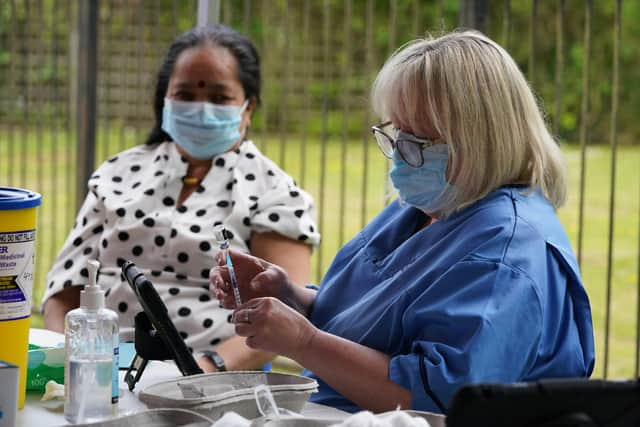Covid Scotland: Case rate falls for first time in four weeks according to Office for National Statistics
Latest estimates show one in 110 people in Scotland had Covid in the week to July 24, down from one in 80 the previous week.
This is the lowest rate since the week to June 26, when the estimate was one in 150 people.
Advertisement
Hide AdAdvertisement
Hide AdSome 1,456 new cases were reported by Public Health Scotland on Friday, an increase of around 60 on the day before, while 474 people were in hospital, 16 fewer than the previous day, while 60 people were in intensive care.


The overall trend of positive cases reported by Public Health Scotland has been falling since the end of June.
While PHS reports depend on people opting to get tested, the ONS survey tests people at random, and so is more likely to catch asymptomatic cases who may not otherwise have been tested and may present a fuller picture of case rates.
The latest ONS estimate for rates England is one in 65 people, up from one in 75 the previous week.
Rates have also risen sharply in Northern Ireland, from one in 170 to one in 65.
In Wales, around one in 160 people are estimated to have had Covid-19 in the week to July 24 – up from one in 210 in the previous week, and the highest level since the week to February 12.
All figures are for people in private households.
Professor Devi Sridhar of Edinburgh University said the report for Scotland merited a “big sigh of relief” as ONS figures align with the recent decline in daily cases reported.
Prof James Naismith, Director of the Rosalind Franklin Institute, and Senior Research Fellow in Structural Biology at Oxford University, said the figures for Scotland were “hopeful”, and may predict good news in future for the rest of the UK.
Advertisement
Hide AdAdvertisement
Hide AdHe said: “There is evidence of a small decline in prevalence in Scotland, which may also be seen in hospital admissions but it is far too early to say. However, where Scotland goes it is likely England will follow in time.”
It comes as a study published in Scientific Reports on Friday suggested the risk of developing vaccine-resistant variants is higher when Covid-19 restrictions are eased before vaccination is complete, as they have been in Scotland and elsewhere in the UK.
Dr Nick Davies, Assistant Professor of Mathematical Modelling at the London School of Hygiene and Tropical Medicine, said on Friday that conclusions in the study “make sense”, but that too much is unknown about the nature of Covid-19 to make solid predictions.
He said: “The probability of a vaccine-resistant strain emerging depends upon two factors: One, the strength of natural selection for a vaccine-resistant strain, which is stronger when the frequency of vaccinated individuals is higher in a given population; and two, the rate at which potential vaccine-resistant mutations may emerge, which of course depends upon how many active infections there are in the first place, as each additional infection represents an additional opportunity for random mutation to produce a vaccine-resistant strain.
"Additionally, a vaccine-resistant strain is less likely to randomly die out during a period in which transmission is higher.”
Thank you for reading this article. We're more reliant on your support than ever as the shift in consumer habits brought about by coronavirus impacts our advertisers.
If you haven't already, please consider supporting our trusted, fact-checked journalism by taking out a digital subscription.
Comments
Want to join the conversation? Please or to comment on this article.
